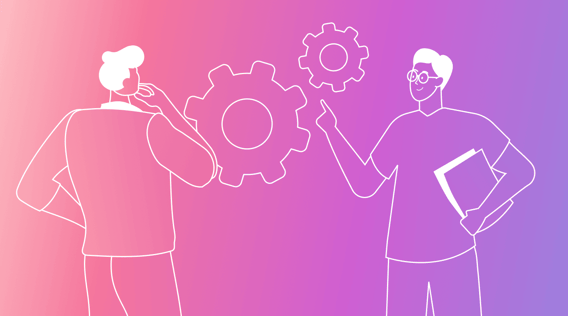Change can be a daunting concept. You create your business process and plan your work, and things are running just fine. Suddenly, you realize something’s not right.
Maybe a competitor is winning when they didn’t before. Maybe your mix of services needs a refresh. Maybe you even see an opportunity to jump ahead. Whatever it is – you know something needs to change.
But change isn’t easy — so how do you go about it?
This is where change management can help.
In this article, we’ll explore the change management process in all its glory. We’ll show you what the process involves, the benefits of using it, and outline some popular change management models you can use in your own business.
What is change management?
Change management is the systematic approach to organizational change. It involves preparing, supporting, and facilitating changes that take you from your current state to a desired future state.
A large part of the process also involves getting your team on board with the change. Implementation becomes more challenging if they’re not invested or willing to make the change happen.
Let’s say that you want to completely rebuild your website. It’s a big undertaking, so you need everyone on board to make it happen.
With change management, you really focus on how to convince your team members that this huge change is worth making. As a result, the entire change process becomes easier to manage, more productive, and creates better morale for everyone involved.
Here are the typical steps of the change management process:
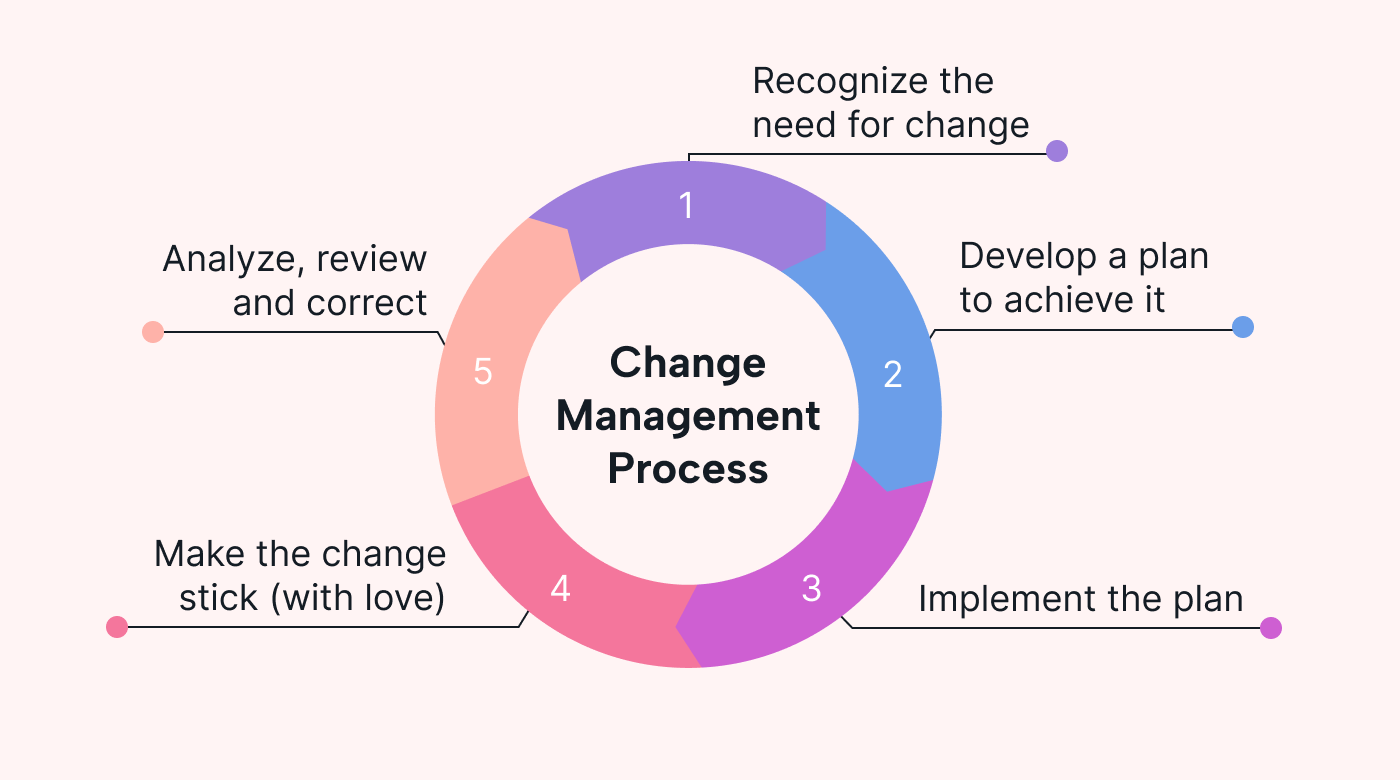 |
These are the generic stages of change management, but the exact steps vary from business to business. It all depends on the change you want to implement, the current state of your business, and the best way to win the hearts of your peers.
Why is change management important?
Outline some of the benefits of a change management process:
- Manage change as smoothly as possible. Change management provides a structured approach to managing the complexities of change. As a result, it reduces disruptions to your workflow and helps you enact change as efficiently as possible.
- Get people on board. A big deal in effective change management is winning the hearts and minds of your people. Real change can’t happen without that, but it’s human nature to resist change. People need to go from “I hear you, but I don’t like it” to embracing the change as enthusiastically as you do. With a change management process, you’re better positioned to convince team members that your change is a good idea and get them 100% behind you.
- Mitigate risks. Change inherently carries risk. There can be disruptions to your work, a decrease in productivity, or negative impacts on employee morale. Change management identifies and assesses these risks, allowing you to develop strategies to mitigate and address them effectively.
What are the common change management models?
Here are some of the common change management models to help you figure out how to manage change in your business.
Kotter’s 8-Step Theory
Kotter’s 8-Step Theory is a framework developed by Dr. John Kotter of Harvard Business School, a leadership and change management expert. It focuses on the importance of engaging employees and stakeholders throughout the organizational change management process.
The theory divides change management into the following stages:
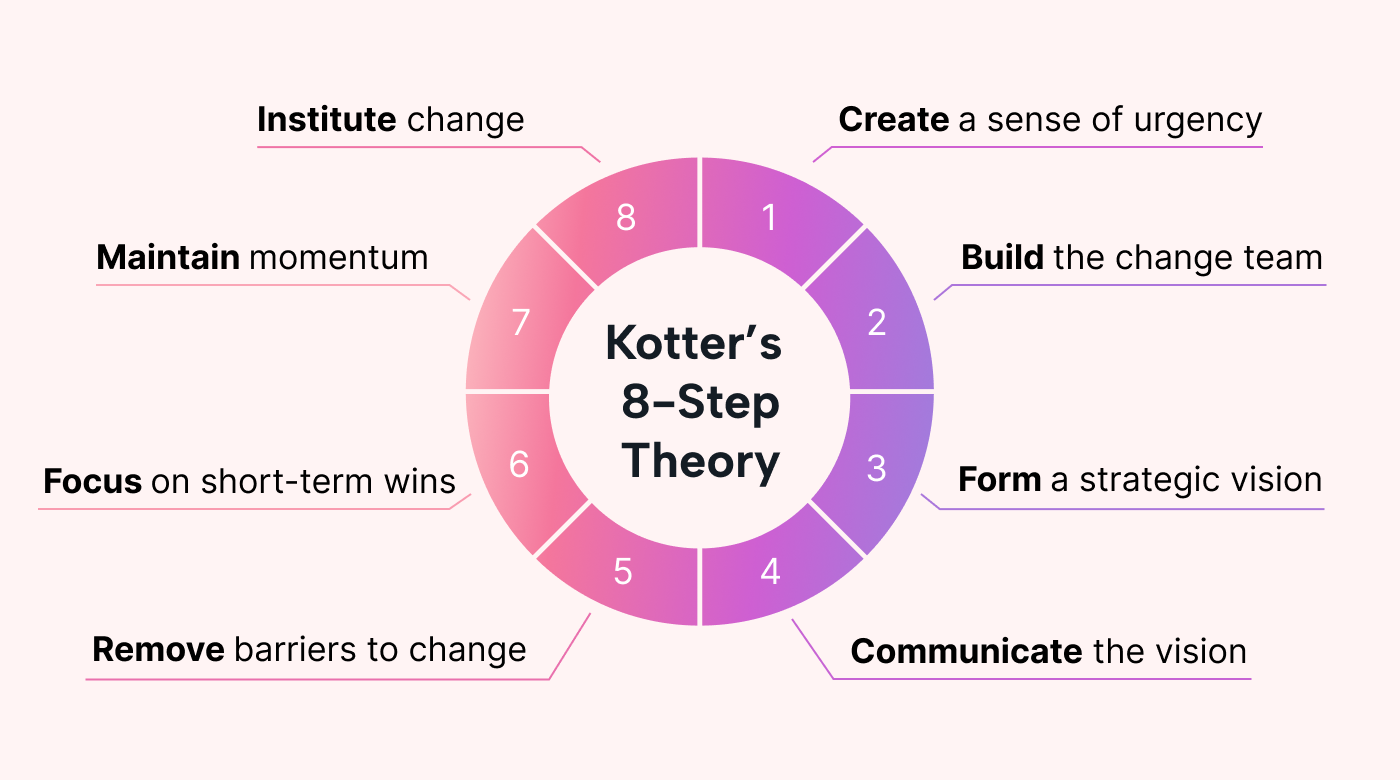 |
Let’s look at these stages in more detail.
- Create a sense of urgency. The first step is to create a compelling reason for the need to change. For example, if you want to launch a new product line, you need to show why this change is vital for the business. As a result, your team understands why the change is necessary, which motivates them to take part.
- Build a guiding coalition. A guiding coalition is a group of influential leaders and stakeholders committed to change. They provide the necessary support and resources to lead the change effectively.
- Form a strategic vision and initiative. Develop a clear and inspiring vision for the future state of the organization after the change. The vision should be concise, easily understandable, and should rally employees behind a common goal.
- Enlist a volunteer army. With the help of your guiding coalition, mobilize a group of enthusiastic and dedicated volunteers to support your change initiative. This involves communicating your vision to the rest of your business and asking volunteers to step forward to help bring the change to life. By the end of this step, you’ll have a dedicated and motivated team behind you.
- Enable action by removing barriers. Identify and address barriers or obstacles that might hinder the change process. For example, budget restraints, bottlenecks, and so on. This step helps you and your team figure out how to overcome challenges and prepare for unexpected hurdles.
- Generate short-term wins. Celebrate and recognize small wins and achievements along the way. Short-term victories help build momentum, boost employee morale, and demonstrate how your change efforts are working.
- Sustain acceleration. Use the momentum from the short-term wins to drive further change and improvements. Continuously build on your success and make necessary adjustments to keep the change process moving forward.
- Institute change. The last step involves making the change feel like part of the company’s DNA. This means making sure everyone understands what the change is, what it means, and how it aligns with the core values and beliefs of your business.
McKinsey’s 7-S Model
McKinsey’s 7-S Model is used to assess how different parts of a business interact and influence each other. Analyzing these elements helps you figure out what change needs to happen and how to implement it effectively.
It divides change management into the following areas:
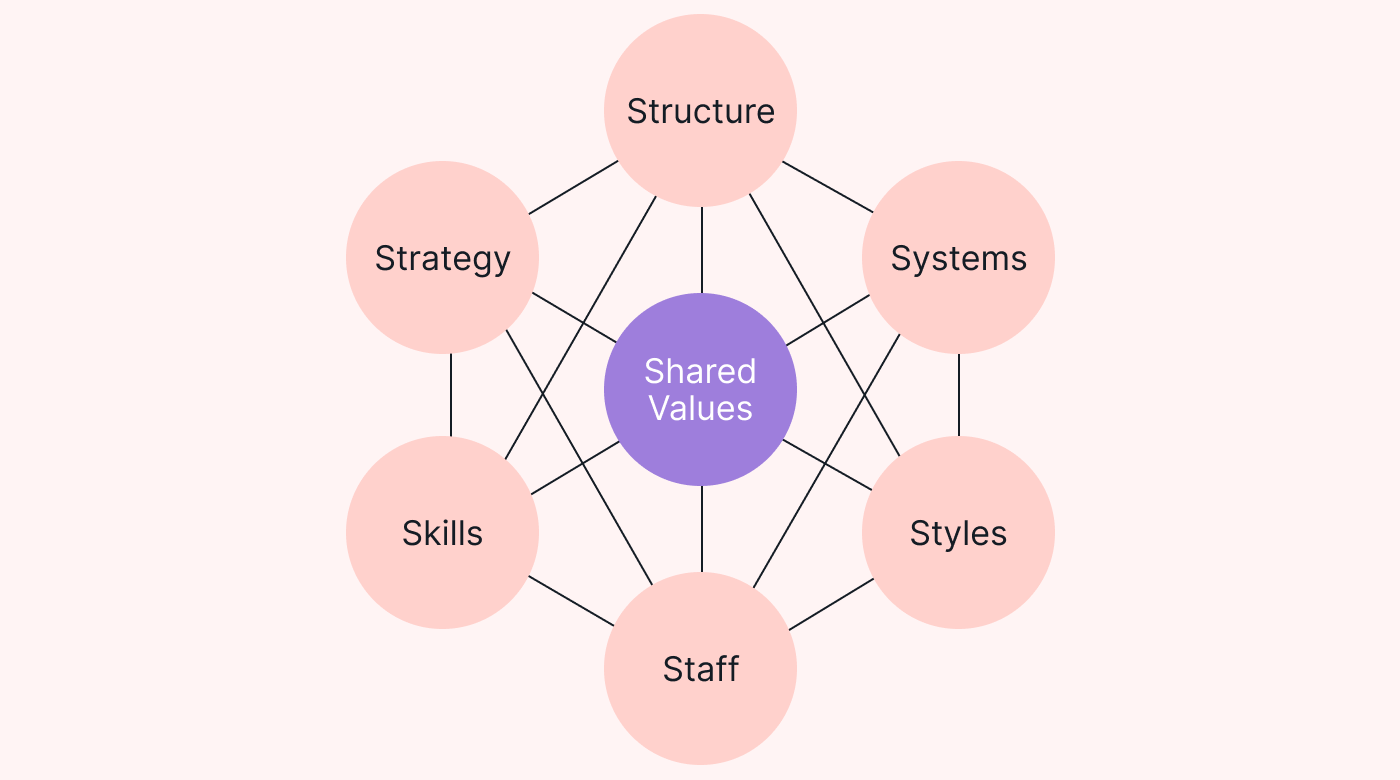 |
Let’s break it down:
- Strategy. The strategy element focuses on how you plan to achieve your goals and objectives, including the specific actions you’ll take to gain a competitive advantage. It should be clear and concise and show team members how your plan aligns with the company’s vision, mission, and values.
- Structure. This refers to the organizational structure of your business. For example, where employees sit in the company hierarchy, how departments relate to each other, and how information flows between them.
- Systems. The systems are the processes that help your business operate. It includes your IT infrastructure, performance measurement systems, and any other processes that help you run your day-to-day activities.
- Shared values. The shared values (sometimes known as superordinate goals) are the beliefs and principles that shape your company culture. These values guide employee behavior and company actions.
- Style. This refers to the leadership and management style prevalent within your company. It covers how top-level managers interact with each other, how they interact with lower-level employees, and the actions they perform as part of their management role.
- Staff. This outlines the number, qualifications, and position of employees in the company. It also includes how employees are recruited, trained, motivated, and rewarded for their work.
- Skills. The abilities and competencies of all employees in your company. This includes technical skills, specialized expertise, communication skills, and more.
Lewin’s 3-Stage Model of Change
Lewin’s 3-Stage Model of Change is a framework that focuses on the importance of “unfreezing” the existing state of your business before introducing change. According to Lewin, this helps reduce resistance and increase acceptance.
The model breaks down big changes into three manageable chunks:
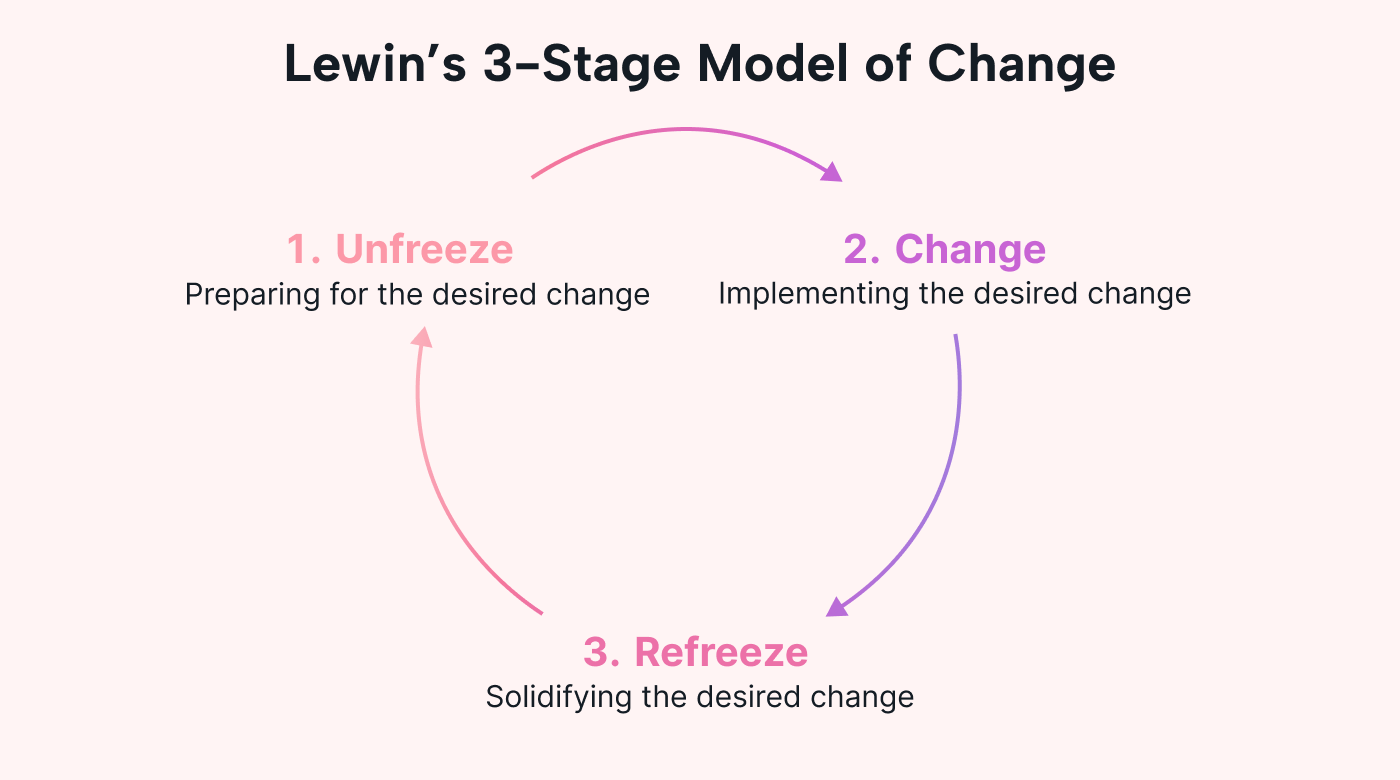 |
Let’s explore these in more detail.
- Unfreeze. In the first stage, the focus is on preparing the organization for change. This involves communicating the need for change, highlighting why the current state is no longer sustainable, and emphasizing the importance of embracing a new direction. Unfreezing helps to create a sense of urgency and a readiness for change among employees.
- Change. In the second stage, you implement your changes and transition to the new state. It may involve restructuring processes, adopting new technologies, revising policies, or modifying the organizational culture. This phase is typically the most challenging. It requires managing resistance (clear communication can help here), overcoming obstacles, and making sure that employees embrace the change positively.
- Refreeze. The final stage is about stabilizing the change. This means reinforcing the changes, solidifying new behaviors, and embedding new practices into your company culture. The aim is to make the changes a permanent part of your organization, preventing you from slipping back into the old ways of doing things.
ADKAR Change Management Model
The ADKAR Change Management Model tracks the stages of employee performance to measure how they feel about the change.
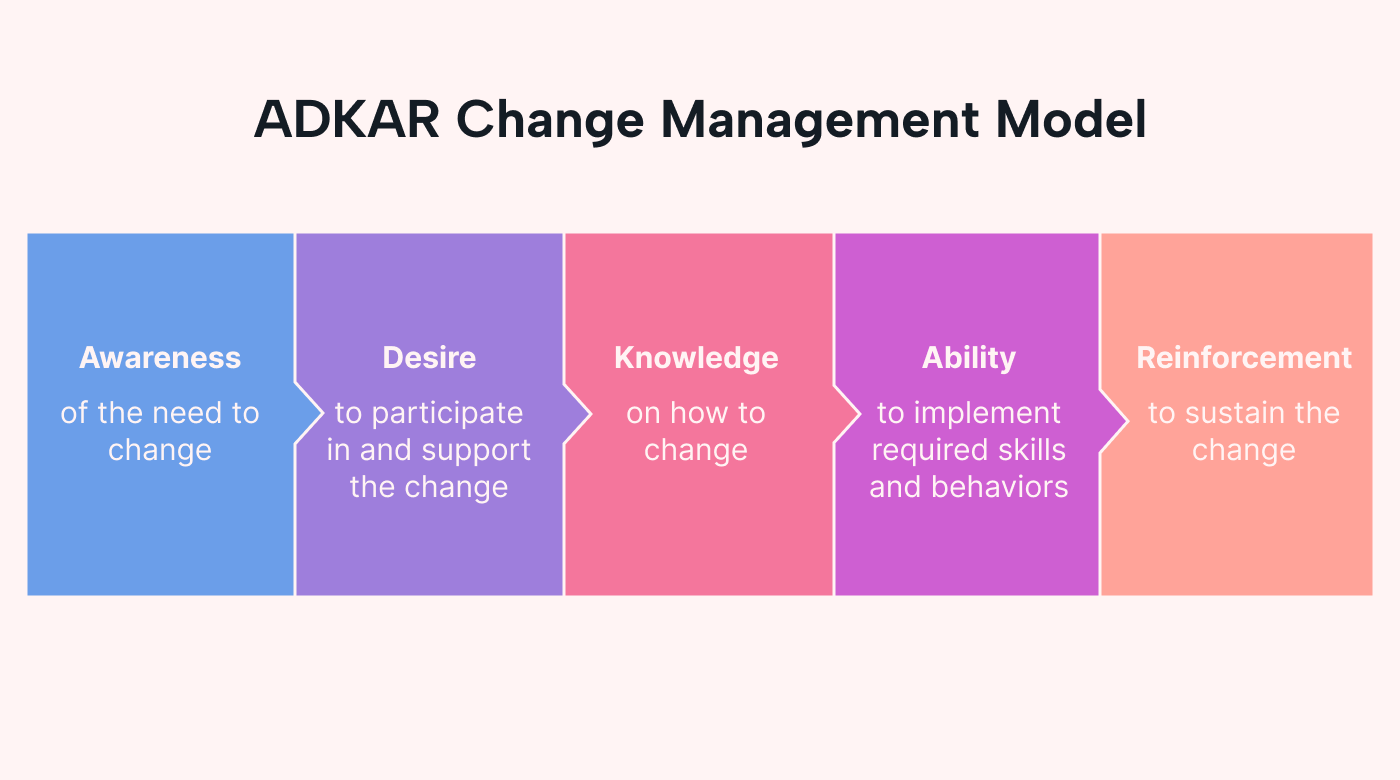 |
Here’s a breakdown of each stage:
- Awareness. The first step is to create awareness about the need for change. To do this, you’ll show people why the change is happening, the reasons for it, and the positive impact it’ll have on individuals and the company as a whole.
- Desire. When people are aware of the change, you need them to want to support and participate in the change — this is where the desire stage comes into play. This step focuses on addressing individual concerns, building a compelling case for change, and fostering a sense of ownership and commitment to the new direction. As a result, people are more likely to support the change.
- Knowledge. The knowledge stage involves providing people with the information, tools, and training they need to implement the change. Giving people access to this knowledge also shows them how the change will affect them and how they can adapt to a new way of working.
- Ability. In the ability stage, people acquire the skills and capabilities they need to implement the change effectively. This may involve hands-on training, coaching, and opportunities to practice new behaviors.
- Reinforcement. The final stage is reinforcement, which focuses on sustaining the change for the long haul. This means embedding the change into the culture of your business until it becomes the new norm.
Top tips for creating a successful change management process
Check out these best practices for successfully managing change in your business.
- Choose the right change management model. Your change management model guides the entire change process, so it’s important to use a model that suits your needs. To choose the best model, think about the type of change you want to implement, the needs of your team, and your company culture. All of these elements will help you choose an effective change management process for your business.
- Assign clear responsibilities. When it comes to enacting change, everyone involved needs to know exactly what their role is and what it involves. That way, there’s no confusion about what needs to happen and why. A platform like Motion is a good tool to use here. With our software, you can easily assign roles and tasks to individual team members so they can instantly see their responsibilities.
 |
- Monitor your change management performance. To make sure your change management process is working, you’ll need to continuously monitor progress. The best way to do this is to set goals before you enact change. Then, you can use these goals as benchmarks to measure success. If things aren’t going to plan, you can make changes or incorporate a different change model.
Use Motion to manage change across your business
Organizational change isn’t always easy. But with a systematic approach, you’re in a much better position to see where you’re going, how to get there, and how to get your team members on board with the change.
Use Motion to manage the change and be transparent with your colleagues. Share real-time updates, collaborate throughout the changes, and record your official change management process in a central location.
Try it for free today.

